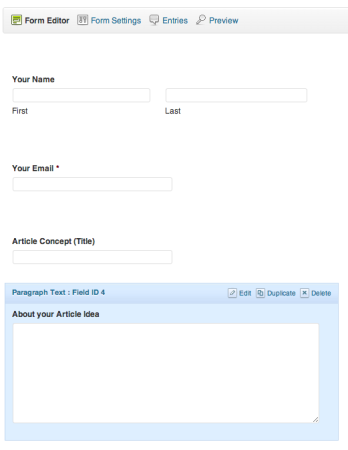When you can integrate Gravity Forms with even more things, life is good, right?
What is Gravity Forms?
If you've never heard of Gravity Forms, it is a premium plugin for WordPress that allows you to build and place forms on your site. Now if that sounds kind of boring, I want you to think about the last five web applications you used.
When you logged into your online bank account, I bet you used forms. When you reserved a hotel or airline ticket, I bet you used forms. When you managed your sales leads, it was all forms, wasn't it.
So to say Gravity Forms helps you build and place forms on your site, it's equivalent to saying that it lets you build applications inside and on top of WordPress.
Until recently, you were limited (that's a truly silly word in this context) in the kinds of systems you could build because of the finite number of add-ons that Gravity Forms produced. That said, if you've not recently searched for other, non Rocket Genius add-ons, do it – because there are tons out there.
But recently they announced a different kind of add-on, which allows you to connect your form to Zapier. And things will now be different. Forever.
What is Zapier?
If you've played with IFTTT, or build point to point integrations, then you know the feeling you get when you've automated something that used to be manual.
Zapier allows non-programmers to create links between two different online systems and move data between them, based on events that trigger in the originating application.
The best thing about Zapier? They integrate with 211 services. That's a lot of integrations that you don't have to code.
Our Example – Integrating Gravity Forms with Basecamp (Classic)
As you know if you've spent time on this blog, I write a daily article. To do that, I am constantly figuring out article topics. To be clear, I only write on WordPress, Business, Presentations and New Product Development. That's it. But each of those topics has tons of things you could write about.
Until recently, that list was something I managed on my own, in Evernote. But recently I created a form to let readers post their own ideas.
But what I really wanted was to not have those items fill up my inbox. I already have too much email. Instead, I wanted them to fill up a Basecamp to-do list.
Could I have coded it directly? Yes. Absolutely. But why? When I am a happy Zapier and Gravity Forms customer?
So today I'm going to walk you thru the specific steps on integrating Gravity Forms with Basecamp.
Step 1. Create a Gravity Forms Form.
Pretty sure you now how to do this. Go into Forms and click New Form. I did that and asked for just a few fields.
Step 2. Place the Form on a Page/Post.
You likely already know how to do this as well. It's really easy. Click the “Add Form” button on the edit screen, and pick your form.
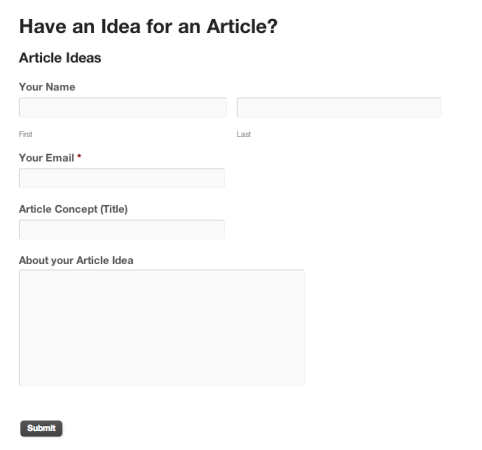 Step 3. Create a Zapier Account / Create a Zap.
Step 3. Create a Zapier Account / Create a Zap.
Now is when you'll want to head over to zapier and create an account. Once you do that, you can click the link to create a new Zap. That's when you'll want to pick Gravity Forms as the trigger, and Basecamp (classic in my case) as the target for the action.
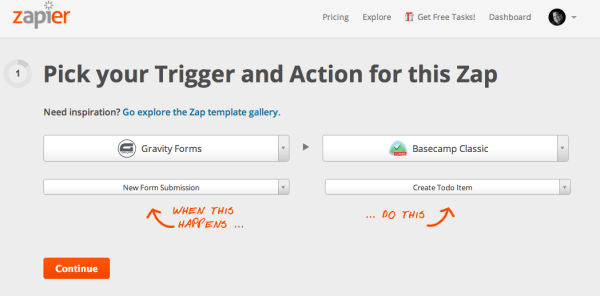 Step 4. Connect Your Form
Step 4. Connect Your Form
Now you're going to head back to your form, and in the form settings, click on Zapier. You'll notice you don't have any feeds created, but don't worry. It will give you a link to where you create one.
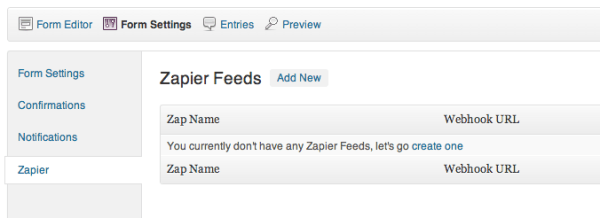 Now, when you click on “create one” you're going to be asked to put a webhook into one of the fields, to connect Gravity Forms to Zapier. That's not an issue, because all you do is go back to Zapier and move to step 2. When you do that, they'll show you the web hook.
Now, when you click on “create one” you're going to be asked to put a webhook into one of the fields, to connect Gravity Forms to Zapier. That's not an issue, because all you do is go back to Zapier and move to step 2. When you do that, they'll show you the web hook.
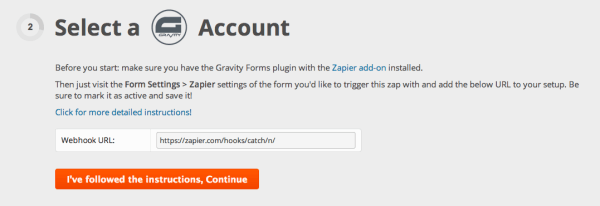 And that's when you take that URL and place it in the feed creation dialogue.
And that's when you take that URL and place it in the feed creation dialogue.
 Step 5. Set up your Target.
Step 5. Set up your Target.
When you've set up the active connection from the Gravity Form to Zapier, you now need to move to the target side of things. In our case, it's all about Basecamp. Start by picking/establishing your connection to your Basecamp account.
As you connect it, you'll get the chance to configure the exact details of the action you want to take. In my case, it's the creation of a to-do, and I am able to use Gravity Form fields (in a merge sort of way) to fill in the values.
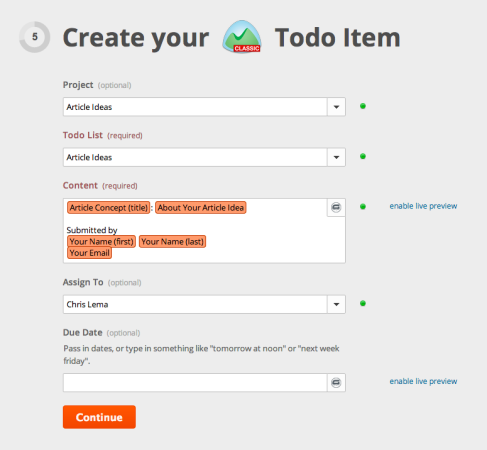 Step 6. Name and Activate your Zap.
Step 6. Name and Activate your Zap.
In our last step, we name and activate our zap. We're even given a chance to test it, but I'll be doing a full test right after this step.
 Test, Test, Test
Test, Test, Test
While our core steps are done, it's still something you want to test. By the way, I should mention that the add-on for Zapier from Gravity Forms is still in beta. So do what you're going to do, given that reality. It will get released soon.
So I built all this on my test server and was then ready to see if it worked. And not only did it work right. It worked fast!
I submitted a form, and then went to Basecamp. And look what I found in my T0-Do list.
 Additionally, I went over to Zapier, and saw this.
Additionally, I went over to Zapier, and saw this.
 That “1” says it just finished processing a single record.
That “1” says it just finished processing a single record.
Going Forward with Gravity Forms and Zapier
I know the guys at Gravity Forms are constantly creating amazing stuff. I've said it a million times but this premium plugin is the only one I think ought to be on every site. I've also stated more than once that I don't think they're charging developers enough for it – given what they can do with it.
With all that said, and I'm sure I'm going to be wrong, but this may be the best thing they'll ever do. Because it's expansive. It opens the door to tons of amazing integrations and projects.
I know they're working on other amazing stuff, so like I said, I'm likely to be wrong. But for now, I'd recommend all developer-license holders to check out Zapier.
And for the rest of you, especially if you build great things with WordPress, why are you still here? Head over to Gravity Forms and pick up a developer license. It will let you connect Gravity Forms with over two hundred other products!


